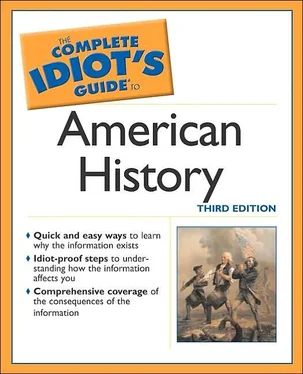The other giants of freighting in the West included George Chorpenning, John Butterfield, John M. Hockaday, and Ben Holladay (who was so successful that he was dubbed the “Napoleon of the Plains”). Yet, if the opportunity for profit was great, the overhead—in livestock, personnel, and maintenance of routes—was staggering. Moreover, stage and freight lines were preyed upon by robbers (popularly called road agents), including the likes of Henry Plummer, Black Bart, the James Gang, and many others who entered into western legend and lore. Sooner or later, most overland entrepreneurs went belly up. Those who survived were either wiped out by the advancing railroads or learned to coordinate their service with the new rail lines, serving the widely dispersed stations as relatively short feeder routes.
After the success of the Erie Canal, completed in 1825 and linking New York City with the Great Lakes, other eastern seaport cities rushed to build systems of canals. Baltimore was an exception and chose to invest not in a canal, but in a brand new technology: the railroad. Begun in 1828, the Baltimore and Ohio Railroad reached the Ohio River, principal artery to the West, by 1852. At about this time, railroads were also being built in the Midwest. The Chicago and Rock Island (The Rock Island Line) became the first rail route to the Mississippi River in 1854. By 1856, the route bridged the river and penetrated the fertile farmlands of Iowa. Other midwestern roads followed.
Practically from the start of all this rail activity, in 1832, a Dr. Hartwell Carver published articles in the New York Courier & Enquirer proposing a transcontinental railroad to be built on eight million acres of government land from Lake Michigan to Oregon (then the only coastal territory to which the United States had any claim). Carver’s scheme came to nothing, and 10 years later, Asa Whitney, a New Yorker engaged in the China trade, proposed to Congress that the United States sell him nearly 80 million acres, from Lake Michigan to the Columbia River, at 16 cents per acre. Whitney planned to sell parcels of the land to settlers and farmers, using the proceeds to push a railroad farther and farther West in pay-as-you-go fashion.
Whitney butted up against Missouri Senator Thomas Hart Benton, who wanted a transcontinental railroad with an eastern terminus at St. Louis rather than Chicago, as Whitney proposed. Benton got Whitney’s plan permanently tabled and, in 1848, persuaded Congress to fund a railroad survey led by his son-in-law, John C. Fremont. The recklessly conducted survey resulted in the deaths of ten of Fremont’s party, frozen or starved in a Rocky Mountain blizzard, and ultimately proved inconclusive.
While arguments over routes raged, the means of financing a transcontinental railroad were being hammered out. Railroad lobbyists proposed a system of government land grants alternating checkerboard fashion north and south of the proposed right-of-way. The railroads would sell their land to finance construction, and the presence of the railroad would greatly increase the value not only of the purchasers’ land, but of the alternate sections retained by the government. A series of such grants was immediately apportioned to a number of western rail lines.
In 1853, Congress authorized Secretary of War Jefferson Davis to conduct detailed surveys of potential transcontinental rail routes. The result of the hasty surveys was, again, inconclusive (though they added significantly to general knowledge of the West). It soon became apparent that Davis—the Mississippian who would become president of the Confederacy with the outbreak of civil war—stacked the deck in favor of a southerly route.
The wrangling might have gone on forever had it not been for one remarkable man. Theodore Dehone Judah (1826-63), son of an Episcopal clergyman in Bridgeport, Connecticut, was a civil engineer with a genius for building railroads. In 1854, Colonel Charles Wilson, president of California’s Sacramento Valley Railroad, commissioned Judah to survey a right-of-way from Sacramento to the gold-mining town of Folsom. Judah reported to Wilson that this stretch of track could serve as something far more significant than a link to Folsom. The track was ideally suited to be the Pacific end of a transcontinental railroad. Wilson and other backers were excited, but then the gold petered out at Folsom, and the rail line went no farther.
Judah did not stop. He lobbied Washington, even as he continued searching for a viable pass across the Sierra Mountains. A frontier pharmacist, Daniel “Doc” Strong, pointed out a likely route, and right then and there, he and Judah quickly concluded an agreement to incorporate a Pacific railroad association. All that was lacking now was money. Lots of money. Judah (lid not stop. He found seven backers, including four whose fortunes were destined to be made by the railroad: Collis P. Huntington and Mark Hopkins, partners in a hardware store; Leland Stanford, wholesale grocer; and Charles Crocker, dry goods merchant. Returning to Washington, D.C., Judah successfully lobbied for passage of the Pacific Railway Act of 1862, authorizing the Central Pacific and the Union Pacific railroads to begin construction of a transcontinental railroad. The Central Pacific would build from the West Coast eastward, and the Union Pacific would build westward from Omaha, Nebraska.
With the North and South torn apart by war, President Lincoln and Congress were anxious to bind the nation together East and West. The Railway Act granted huge tracts of land to the railroad, along with massive construction loans, and, at the behest of Abraham Lincoln, multimillionaire congressman Oakes Ames and his brother Oliver created a corporation to build the railroad and another corporation to finance construction. The latter was named Credit Mobilier, after the company that had successfully financed the French railway system 10 years earlier. The Ames brothers made investors an offer they couldn’t refuse: Credit Mobilier, run by the directors (principal investors) of the Union Pacific, was paid by the Union Pacific to build the Union Pacific. The directors made a profit on the railroad as well as on the cost of building it. The scheme was an open door to fraud, and construction bills were routinely padded.
In the end, scandal and greed could take nothing away from the heroism and wonder of what it meant actually to build a transcontinental railroad—especially in an age when earth was moved and iron rails laid not by machines, but by human muscle.
Under the leadership of Grenville Mellon Dodge and another ex-army general, John Stephen Casement, the Union Pacific began laying prodigious lengths of track—266 miles in 1866 alone. The tracks were set into place mostly by unskilled Irish immigrants, who received, in addition to their pay, room and board. On the Central Pacific, the bulk of the work force was Chinese, who were paid about the same rate but had to furnish their own tent accommodations and their own food.
Laying and spiking 500-pound rail sections was difficult enough, but these men—some 25,000 in all—faced other perils as well. They encountered harsh weather on the prairies and in the mountains, including summer floods, winter blizzards, and the ever-present danger of avalanche; attack from Sioux and Cheyenne, as the rails penetrated Indian hunting grounds in western Nebraska and southeastern Wyoming; and unceasing pressure from bosses, who had little love for Irish immigrants and even less for Chinese “coolies.” Taskmasters drove the laborers relentlessly, heedless of life and limb, for the Central Pacific and Union Pacific, though they would be joined, were actually in fierce competition. The volume of their government land grants were directly proportional to the amount of track laid. In fact, in the absence of an officially predetermined meeting point for the converging tracks, survey parties laid out some 200 miles of overlapping, parallel, entirely redundant right-of-way. After roustabout parties passed each other-blasting away at hard rocks and almost at one another-U.S. Secretary of the Interior Orville H. Browning intervened and named Promontory Summit, 56 miles west of Ogden, Utah, as the meeting point. (Many histories of the West confuse Promontory Summit with nearby Promontory Point.)
Читать дальше












